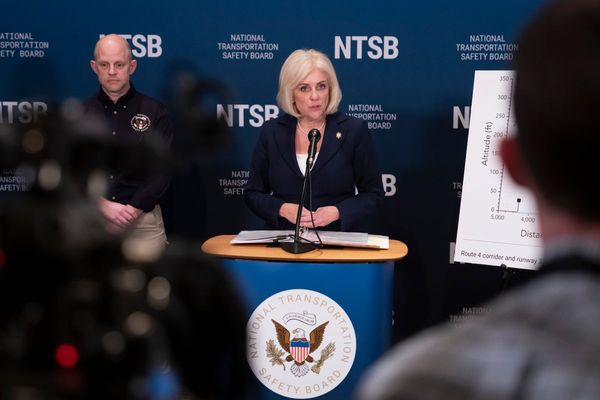
Wall Street's biggest banks are boosting the odds of a near-term recession in the world's largest economy, citing a weakening labor market and softer growth prospects that could compel the Federal Reserve to signal deeper interest-rate cuts over the coming months.
Recession fears have played a key role in the recent market turmoil, alongside the unwinding of leveraged foreign-currency trades and concern that the Fed has left its benchmark lending rate too high for too long. All this has lopped more than $6 trillion in value from global stock markets over the past three weeks.
Concerns began to emerge earlier this summer, when the Labor Department's monthly employment reports started to show sharp downward revisions to prior estimates.
That was cemented with a weaker-than-expected July payrolls report that showed not only muted overall hiring but slowing wage gains and the highest headline unemployment rate in three years.
That report in fact triggered a new, and previously little known, recession gauge known as the Sahm Rule, created by the former Fed economist Claudia Sahm.

The rule is designed to identify recession in real time by observing changes in the three-month average of unemployment rates. Recessions are usually formally certified by the National Bureau of Economic Research several months after they occur.
The Sahm rule: Elaboration by the author
Sahm herself wrote in a Bloomberg opinion piece Wednesday that the U.S. is "not in a recession, despite the indicator bearing my name saying that it is." But she noted that "the risk of a recession is elevated, strengthening the case for the US Federal Reserve to cut interest rates."
JP Morgan economists, meanwhile, have boosted the odds of near-term recession sharply, pegging the chances that the U.S. economy slumps into contraction by the end of the year at 35%, up from a prior estimate of 25%.
"U.S. wage inflation is now slowing in a manner not seen in other [developed-market] economies," said the JP Morgan team lead by Bruce Kasman. "Easing labor market conditions increase confidence both that service price inflation will move lower and that the Fed's current policy stance is restrictive."
Related: Jobs report triggers key recession warning signal as stocks plunge
That call also was made by economists at Goldman Sachs in a note published Sunday as the bank raised its down recession odds to 25% from 10%. But it seems a long way from the economy's current pace.
The Atlanta Fed's GDPNow forecasting tool, a real-time indicator, suggests a current-quarter growth rate of 2.9%, updated from 2.5% on Aug. 6.
Mixed U.S. economic growth data
The Institute for Supply Management, meanwhile, published its closely tracked reading of service sector activity earlier this week. The gauge showed the economy's most-important sector running well ahead of the 50-point mark, which separates growth from contraction.
"The rebound in the key components of the ISM services survey in July should ease fears that the economy is nosediving," said Ian Shepherdson of Pantheon Macroeconomics. "The headline index recovered to stand just 0.2 points below its average in the first half of this year, when GDP rose at a decent pace."
Related: Goldman Sachs analyst revisits S&P 500 target after market meltdown
Other metrics that suggest near-term weakness, however, are also starting to mount, with credit-card-delinquency rates rising to the highest levels in a decade and consumer spending starting to fade.
Small businesses, meanwhile, are reporting the hardest credit conditions since the early 1990s and have pulled back on hiring intentions as a result.
"Consumers are feeling the pressure from elevated price levels and slowing income growth," said Jeffery Roach, chief economist for LPL Financial in Charlotte.
Fed's rate path in focus
"The deterioration of financial conditions and softer trajectory for consumer spending increase the odds of the Fed acting more aggressively at the September meeting," he added.
Fed rate cuts could certainly soften some of the impact of weakening growth prospects, with JP Morgan calling for at least a full point of reductions over the next three meetings, starting with an outsized cut in September.
CME Group's FedWatch pegs the chances of a 50-basis-point (0.5-percentage-point) interest-rate cut next month at around 70.5%, and it sees the Federal Funds Rate falling to 4.375%, a full point from its current level, by the end of the year.
More Economic Analysis:
- Black Monday on Wall Street: 5 reasons stocks are plummeting
- After the Fed tipped markets over, now what?
- Jobs report triggers key recession warning signal as stocks plunge
“With the benefit of hindsight, it’s easy to say the Fed should have cut this week,” JP Morgan economist Michael Feroli said late last week. “Even if the softening in labor market conditions moderates from here going forward, it would seem the Fed is at least 100 basis points offsides, probably more.”
Goldman economists see modest improvements in the labor market over the month of August keeping the Fed from making the larger half-point reduction.
But they conceded that "if we are wrong and the August employment report is as weak as the July report, than a 50-basis-point cut would be likely in September.”
Related: Veteran fund manager sees world of pain coming for stocks







